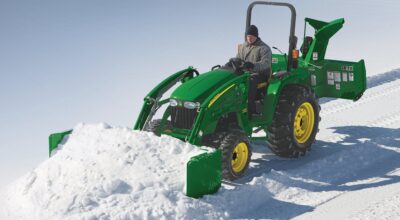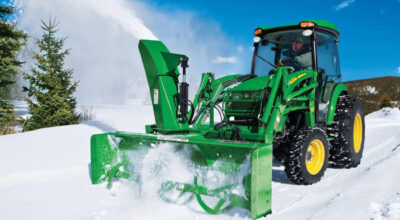A John Deere tractor can become a property owner’s best friend during the winter when it’s paired with a tractor-mounted snowblower. However, there are a few steps that should be taken by all operators before, during, and after use.

Here are six critical steps to take when using a tractor-mounted snowblower to clear some space this winter:
- Hook up the snowblower
- Adjust the skid shoes
- Adjust the chute
- Adjust the deflector angle
- Maintain steady speed
- Clean out the equipment
1. Hook Up the Snowblower
If you own a John Deere tractor with iMatch™ Quick Hitch capabilities, lock down the blower to the iMatch and make sure the equipment is level from the front to the back by adjusting the top link if necessary. Then, attach the PTO shaft to the tractor, close the driveline shield, and attach the safety chain.
2. Adjust the Skid Shoes
Once the snowblower is attached to the tractor, be sure to adjust both skid shoes so they provide about an inch of ground clearance. This will help to protect both the snowblower and the surface that is being cleared from damage.
3. Adjust the Chute
When you’ve arrived at the job site and you’re ready to begin clearing the snow, adjust the chute to blow the snow in the desired direction. Remember, check for the wind direction to make sure the chute isn’t sending the snow against it.
4. Adjust the Deflector Angle
Next, you’ll want to adjust the deflector angle for blowing snow the preferred distance. Always be sure the angle is adjusted so the snow is being cleared into a space that will not need to be worked on in the near future.
5. Maintain Steady Speed
The auger of most snowblowers can chew up a lot of snow at once, but even with a powerful piece of equipment, it’s important to remember to travel at a steady and moderate speed while operating. By doing so, the equipment will be able to take on all the snow that needs to be cleared without becoming overloaded.
6. Clean Out the Equipment
Be sure to clean out the equipment after every use. Pay especially close attention to removing snow from the auger, impeller, and chute, as snow left behind in these areas could prevent the equipment from operating properly the next time it’s started.
By following the above steps, you and your property will be better prepared to use a tractor-mounted snowblower to clear an area.
For more information about using a tractor-mounted snowblower, visit this page.
If you enjoyed this post or want to read others, feel free to connect with us on Facebook, or Twitter!


